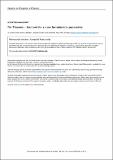Files in this item
Tin titanate – the hunt for a new ferroelectric perovskite
Item metadata
| dc.contributor.author | Gardner, Jonathan | |
| dc.contributor.author | Thakre, Atul | |
| dc.contributor.author | Kumar, Ashok | |
| dc.contributor.author | Scott, James F | |
| dc.date.accessioned | 2020-08-26T23:34:33Z | |
| dc.date.available | 2020-08-26T23:34:33Z | |
| dc.date.issued | 2019-08-27 | |
| dc.identifier | 260421286 | |
| dc.identifier | 63aaf647-aead-4922-a9d2-3b4b9dbf3da7 | |
| dc.identifier | 85071709559 | |
| dc.identifier | 000483098200001 | |
| dc.identifier.citation | Gardner , J , Thakre , A , Kumar , A & Scott , J F 2019 , ' Tin titanate – the hunt for a new ferroelectric perovskite ' , Reports on Progress in Physics , vol. 82 , no. 9 , 092501 . https://doi.org/10.1088/1361-6633/ab37d4 | en |
| dc.identifier.issn | 0034-4885 | |
| dc.identifier.other | Bibtex: urn:c6ba8ee74be35dd8cccdbd27dbc829ba | |
| dc.identifier.uri | https://hdl.handle.net/10023/20519 | |
| dc.description | This work was supported in St Andrews by the Engineering and Physical Sciences Research Council (EPSRC) Grant No. EP/P024637/1. | en |
| dc.description.abstract | We review all the published literature and show that there is no experimental evidence for homogeneous tin titanate SnTiO3 in bulk or thin-film form. Instead a combination of unrelated artefacts are easily misinterpreted. The X-ray Bragg data are contaminated by double scattering from the Si substrate, giving a strong line at the 2-theta angle exactly where perovskite SnTiO3 should appear. The strong dielectric divergence near 560K is irreversible and arises from oxygen site detrapping, accompanied by Warburg/Randles interfacial anomalies. The small (4μC/cm-2) apparent ferroelectric hysteresis remains in samples shown to be pure (Sn,Ti)O2 rutile/cassiterite, in which ferroelectricity is forbidden. Only very recent work reveals real bulk SnTiO3, but it possesses an ilmenite-like structure with an elaborate array of stacking faults, not suitable for ferroelectric devices. Unpublished TEM data reveal an inhomogeneous SnO layered structured thin films, related to shell-core structures. The harsh conclusion is that there is a combination of unrelated artefacts masquerading as ferroelectricity in powders and ALD films; and only a trace of a second phase in PLD film data suggests any perovskite content at all. The fact that X-ray, dielectric, and hysteresis data all lead to the wrong conclusion is instructive and reminds us of earlier work on copper calcium titanate (a well-known boundary-layer capacitor). | |
| dc.format.extent | 2056707 | |
| dc.language.iso | eng | |
| dc.relation.ispartof | Reports on Progress in Physics | en |
| dc.subject | Ferroelectric | en |
| dc.subject | Lead-free | en |
| dc.subject | Room-temperature | en |
| dc.subject | Tin titanate | en |
| dc.subject | QC Physics | en |
| dc.subject | QD Chemistry | en |
| dc.subject | T-NDAS | en |
| dc.subject.lcc | QC | en |
| dc.subject.lcc | QD | en |
| dc.title | Tin titanate – the hunt for a new ferroelectric perovskite | en |
| dc.type | Journal item | en |
| dc.contributor.sponsor | EPSRC | en |
| dc.contributor.institution | University of St Andrews. School of Chemistry | en |
| dc.contributor.institution | University of St Andrews. School of Physics and Astronomy | en |
| dc.contributor.institution | University of St Andrews. Condensed Matter Physics | en |
| dc.identifier.doi | https://doi.org/10.1088/1361-6633/ab37d4 | |
| dc.description.status | Peer reviewed | en |
| dc.date.embargoedUntil | 2020-08-27 | |
| dc.identifier.grantnumber | EP/P024637/1 | en |
This item appears in the following Collection(s)
Items in the St Andrews Research Repository are protected by copyright, with all rights reserved, unless otherwise indicated.

